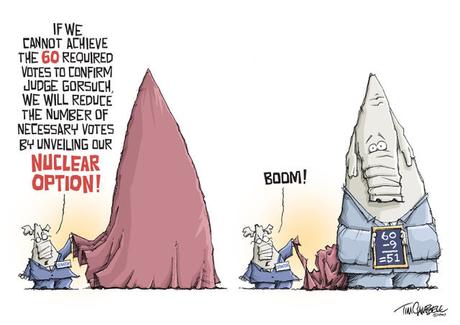
(Cartoon image is by Tim Campbell in the
Weatherford Democrat.)
It's official now. As of yesterday, the Senate Democrats had enough votes to sustain a filibuster against approving Gorsuch as a Supreme Court justice. They have 41 confirmed votes, which means the Republicans cannot reach the magic number of 60 -- the number of votes it would take to end a filibuster.
The question now is what will the Republicans do? They could let Gorsuch's nomination die due to the filibuster. I doubt they'll do that. That would mean another defeat for the Republicans and for Donald Trump coming on the heels of the ignominious defeat of their attempt to repeal Obamacare -- and signal to their base that they might not be able to keep any of their campaign promises. They need to get Gorsuch approved.
The only way they can do that now is to pull the trigger on the "nuclear option" (i.e., change the time-honored Senate rule that allows a filibuster of Supreme Court nominees). They could throw out the filibuster of Supreme Court nominees and allow them to be approved on a simple majority vote.
I think they will do that, but they need to understand something -- once the filibuster rule is gone, it is gone for good. They won't be able to reinstate it when the Democrats take control of the Senate and White House (which looks likely considering the unpopularity of the Trump administration). That means that a future Democratic president could get nominees to the Supreme Court approved much more easily -- and their could be a bunch of them after 2020 (considering the ages of many current justices).
The Republicans can get Gorsuch approved, but doing so could bite them in the butt in the future.
For those of you who are interested, here is the nine-step process for invoking the "nuclear option" (from
USA Today):
1. Reconsider
Immediately after Gorsuch fails to win the 60 votes needed to overcome a filibuster, Senate Majority Leader Mitch McConnell, R-Ky., could make a motion for the Senate to reconsider that failed vote (called a cloture vote). His motion cannot be debated and would need only a simple majority of the votes cast to pass, which is key since Republicans hold a slim majority of 52 seats. If that motion to reconsider passes, then....
2. Point of Order
McConnell could raise a "point of order" basically declaring that it will now take only a simple majority of senators (rather than three-fifths) to end a filibuster and advance Gorsuch's nomination to a final up-or-down vote.
3. Ruling of the chair
The Republican senator presiding over the session that day (and sitting in the big chair at the top of the dais) would rule against McConnell's point of order because it contradicts current Senate rules. This is all part of a carefully choreographed procedural dance, so McConnell would be expecting this.
4. Appeal the ruling
McConnell would then appeal that "ruling of the chair" and ask senators to vote to overrule it.
5. Vote to overrule
The Senate would vote on whether to overrule the chair. Once again, Republicans need only a simple majority to win this vote. If the ruling is overturned, then...
6. Democratic point of order
Senate Minority Leader Chuck Schumer, D-N.Y., could raise a point of order essentially declaring that the old rules should still be followed, and 60 votes should still be required to end the filibuster on Gorsuch's nomination.
7. Ruling of the chair II
The presiding officer (who, remember, would be a Republican) would surely rule against Schumer.
8. Vote to overrule II
Schumer could then appeal that ruling and ask for a vote, which he would undoubtedly lose. If the ruling of the chair was upheld, it would confirm the new rule requiring just a simple majority to advance Gorsuch's nomination.
9. Re-vote cloture (to end filibuster)
Finally, the Senate would vote on the cloture motion, which Republicans would be able to pass easily, ending the Democratic filibuster. That would clear the way for an up-or-down vote on Gorsuch.
 (Cartoon image is by Tim Campbell in the Weatherford Democrat.)
(Cartoon image is by Tim Campbell in the Weatherford Democrat.)
